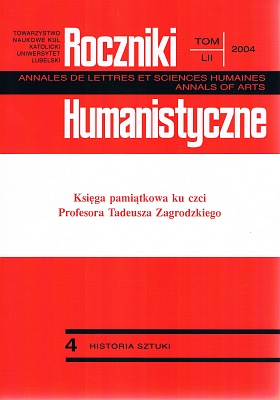Ideological contents of the paintings of church interiors. A few remarks on Cornelis de Man’s painting
Abstract
Cornelis de Man's painting The Interior of an Old Church, a View from the South Aisle to the East, about 1660-1665 (in the collection of the Museum in Gdańsk), has been considered to be a view of the New Church in Delft so far. The painting is an example of the mature stage of the Delft architectural painting. Hendrick van Vlieta's painting The Interior of Oude Kerk in Delft with the Tomb of Piet Hein (formerly the Cook Collection, Richmond, 1652-53) was the inspiration for the work.
An additional element – trompe l'oeil – introduced to the painting by de Man is the painted curtain. The suspended violet curtain unmasks the fiction of the painting and is supposed to raise the illusionist power of art (the signature of the artist is exposed on the column). So the painting is a symbol of the power of imagination and of the sense of seeing. The curtain in de Man's Gdańsk work is an expression of a certain extravagance, it shows that it is a collector's item, it presents and raises the charm of the painting. The fact that de Man undertook painting a view of a church with a tomb of a Catholic bishop (who in fact was not there) proves that there must have been an employer who felt a bond with the place, maybe a member of the family, who wanted to commemorate the late person in such a way, or one who felt a special sentiment to that part of the church or town.
The figure of the boy standing at the grating with his back towards the viewer, is seen again in the picture attributed to de Man by Liedtke, The New Church in Delft with the Tomb of William the Silent, painted probably in 1660 (the Netherlands, a private collection). Generally, Cornelis de Man's painting should be interpreted in the context of Psalm 90 marked on the pulpit, whose reflections are connected with sin as the cause of shortness and scantiness of human life, seen in the perspective of a valuable life with the hope of God's grace. In the image of the curtain revealing the interior of the church a Christian's turning to Christ is symbolized with reference to II Cor 3,16. The Old Testament covered with a veil – and in the New Testament it is taken away in Christ, in freedom of a Christian for whom the Church is a gate, and the Christian, similar to the corner stone, has become a significant part supporting the structure. The dogs appearing in the painting are a reminder of everyday life and of their role as ones who explain human behavior, which stresses the significance of their figures.
Cornelis de Man's painting is one of his early works, falling on 1660's. Its monumental character, the high point of view, patches of light behind the windows, subtle shadows – make the viewer perceive it as a scene that is observed in a natural and accidental way. Apart from the Columbus painting and the view of the interior of Laurenskerk in Rotterdam (Koninklijk Kabinet van Schilderijen, The Hague, Mauritchuis) the painting is de Man's best contemplative church interior.
Copyright (c) 2004 Roczniki Humanistyczne

This work is licensed under a Creative Commons Attribution-NonCommercial-NoDerivatives 4.0 International License.





